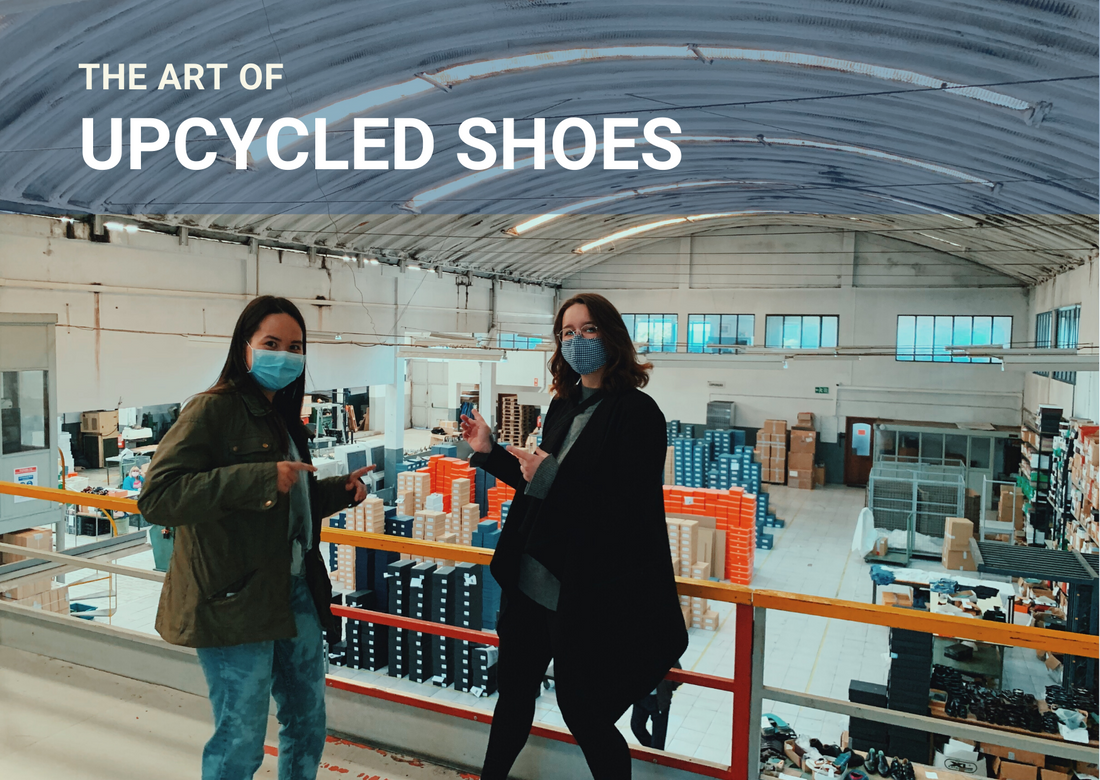
The art of upcycled shoes
Share
Lili and Martina here with a small production and factory update! We spent all of last week at our shoe factory in Portugal and saw the whole shoemaking process. Even though this wasn’t the first time we got to witness the magic happen, we had changed quite a few steps during this production round. So we definitely wanted to be on the ground when the shoes were made to ensure that everything went smoothly and learn for the next production rounds to come.

Why is each round different you might ask?
Well, since we started making upcycled shoes last year, we have constantly been experimenting with new materials and new methods with the goal to optimize the process as much as possible. Specifically, we are finding new ways to make the production faster and more efficient (less mistakes and less cut-offs). The reason why we have to do this, compared to other shoe companies that use new fabrics on rolls, is because our textiles are… well… a bit weirdly shaped (as you can see on the image below), which means that from putting backing on the jeans (to stabilize the textile and make it more durable) and cutting out pieces of the shoes, our amazing factory workers have to find creative ways to make it work so it fits with their current production methods. We will take you through some of the steps that go into shoe making and explain how we do it!
Step 1: Putting backing on the jeans
As we mentioned above, the first step is to put reinforcement on the textile we use for the shoes. Doing so ensures that the fabric is more stable and durable. We use biodegradable backing, that allows us to recycle the shoes when it reaches end-of-life (read more about the specific materials here).
In the first production round it was actually us and a few people from the factory who put the jeans and backing together. It worked well, but it took quite a bit of time and some of the fabric became a little wrinkly. This time, we decided to outsource this step to a factory that specializes in putting backing on fabric and can do many meters in one go. We concluded that this was definitely the right choice, because they managed to do it a lot quicker AND there were less mistakes in form of fabric wrinkles. One of the learnings we got was that the backing factory is definitely not used to working with small pieces of fabric, so the jeans were placed too far away from each other. We asked the factory to make sure they maximize the backing real estate and make it more dense. It worked! But there are still improvements to be made :).
Step 2: Cutting the pieces of textile that will form the shoe
This is the step that we managed to optimize the most between production round #1 and production round #2. And it is all thanks to the metal molds that we got made. They are used on a pressure machine that cuts the patterns out (just like a cookie cutter) - this saved A LOT of time compared to the first production round, where each pattern piece was hand cut. The cutting of the fabric on the pressure machine is something quite fascinating, so we spent a lot of time filming timelapses to show the process (which you can see on our Instagram). We are also making a whole video about production, where you can see how it is done in more detail - so stay tuned!

Step 3: Sewing, Sewing, Sewing and Sewing.
After the fabric has been cut all the pieces have to be put together. Even though we are grouping it into one step, there are maybe 40 small tasks that we saw the wonderful ladies in the factory do. In general the fabric is glued together (with water-based glue), then sewn together, lining is put on what will be the inside of the shoe, there is foam placed in between fabric to make the heel area soft. Honestly - we could barely keep track of it! But at the end of it, the top of the shoe is ready to be sewn together with a thin sole and the assembly steps can begin!

Step 4: Putting the shoe together
Now this is the most intriguing part of the process. Imagine that a lady picks up a funky looking piece of fabric and a strobel sole (very thin fabric sole) and sews it together and suddenly it looks like a shoe! Then the shoe goes on a journey that will be finalized by the shoe getting neatly packed in a box.
But before it is completely ready… The shoe is shaped and then set in a heating and cooling machine. This step begins the process of forming the shoe into a real shoe shape. After that, it is placed on a conveyor belt, a last (basically a mannequin foot) is put into it and honestly just a lot of heat is applied- and a lot of hammering and drawing on the shoe happens. Afterwards some glue is applied and the sole is applied. The final few steps involve sewing the sole and the upper together, putting in the shoelaces and of course - quality control. We can attest that the whole process is pretty crazy and amazing to watch!

Final remarks
So first of all, keep in mind that this is an extremely simplified explanation of the process- but we hope it still gives some insights into how our shoes are made. Secondly, we not only spent the week observing in the factory, but we also filmed every step. And in a few weeks we will share a video that will show you everything in action (yes, we know it is a long time to wait - but we want to make sure the video is as good as possible :) ).
The last thing we wanted to tell you about, is the factory we work with. When choosing factories we of course wanted to stay in Europe and we wanted to work with someone who provided good working conditions for their employees. What we didn’t realize was that not a lot of factories would be willing to work with us haha. This was because we didn’t really make it easy for them. As you can see above- the material we work with (discarded textiles) is far from typical. And we needed to find a way to prepare the material in a way that could be used for the current production methods.
This is why we are so grateful for our amazing production partner in Portugal. We managed to find a family-owned and run factory that has been around for over 50 years! They have been making shoes since 1972! The owners span across two generations and they love shoe making. We can really say that we feel how forthcoming they are about every little idea we come up with. Most importantly, they have a very nice work environment for their employees. There are about 60 people working at the factory and most of them have worked there for over 20 years - and honestly everyone is extremely happy and welcoming. We are currently working on mapping the social impact of our sneakers, as soon as we have that, we will share more details on what exactly makes this factory a great place to work for the people making the VAER sneakers. We are so fortunate to have found such a great partner, and right now we are looking forward to the next production round so we can go visit them again :)
If you have any questions feel free to reach out to us!
